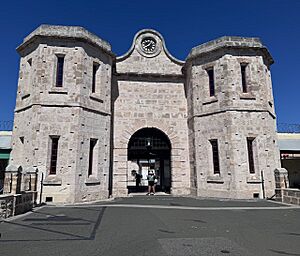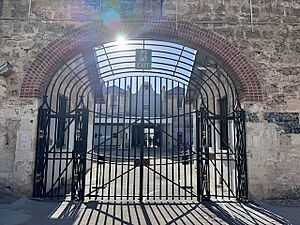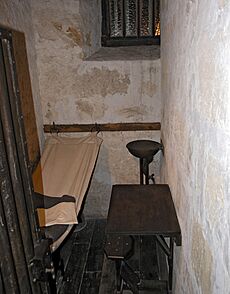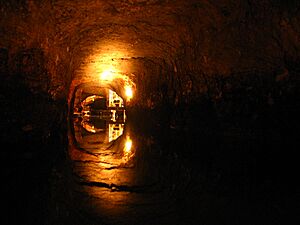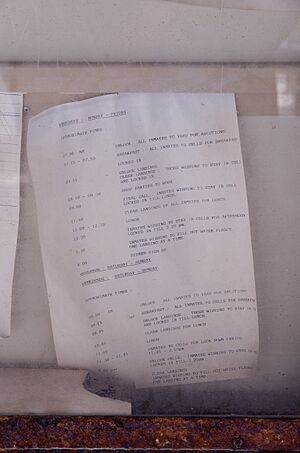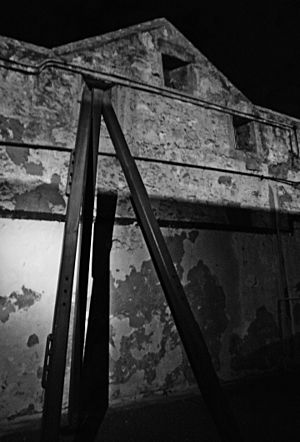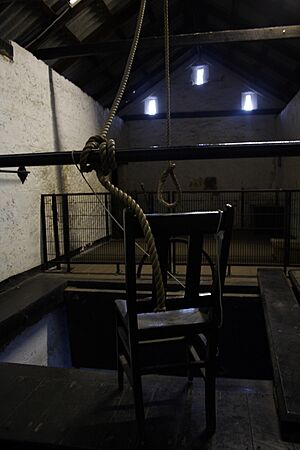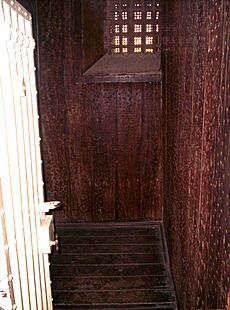Fremantle Prison facts for kids
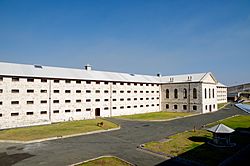
Main Cell Block
|
|
| Location | Fremantle, Western Australia |
|---|---|
| Coordinates | Lua error in Module:Coordinates at line 614: attempt to index field 'wikibase' (a nil value). |
| Status | Closed; heritage site |
| Security class | Maximum |
| Opened | 1855 |
| Closed | 30 November 1991 |
| Managed by | Department of Planning, Lands and Heritage |
| Street address | 1 The Terrace |
| Type: | Cultural |
| Criteria: | iv, vi |
| Designated: | 2010 (34th session) |
| Part of: | Australian Convict Sites |
| Reference #: | 1306 |
| Region: | Asia-Pacific |
| Type: | State Registered Place |
| Designated: | 30 June 1995 |
| Reference #: | 1014 |
Fremantle Prison is a famous old prison in Fremantle, Western Australia. It's also known as Fremantle Gaol or Fremantle Jail. This historic site includes the prison buildings, walls, and even tunnels. It started as a place for convicts sent from Britain.
Later, in 1886, the local government took over the prison. It then held people sentenced for crimes in Western Australia. The prison saw some changes over the years, especially in the 1960s. However, the prison's old ways were hard to change.
In 1988, there was a big riot where guards were taken hostage. A fire also caused a lot of damage. Fremantle Prison closed in 1991. A new, modern prison called Casuarina Prison took its place.
Today, Fremantle Prison is a special heritage site and a popular tourist attraction. It's even part of the Australian Convict Sites on the World Heritage List. This means it's recognized as important to the world's history.
Prison Design and Buildings
Fremantle Prison was built on a large piece of land using limestone from the area. A tall wall, about 15 feet high, surrounds the prison. A gatehouse stands in the middle of the western wall.
Outside the wall, there are cottages where prison workers and officials lived. Inside, you'll find the parade ground and the Main Cell Block. This main block has two chapels. Other buildings include New Division, the former Women's Prison, a hospital, and workshops.
Underneath the eastern part of the site, there's a system of tunnels. These tunnels were built to get fresh water from underground.
Houses on The Terrace
Near the gatehouse, there are several old houses. Some are in a Victorian style, while others are Georgian. These houses were home to important prison staff. This included the chaplain, superintendent, and gatekeeper. They remained homes for prison officers until the 1970s.
The Gatehouse Entrance
The gatehouse was built between 1854 and 1855 by convicts. It was designed by Edmund Henderson, a Royal Engineer. The gatehouse looks like a castle entrance from the 13th century. It has two towers and a narrow gate. The iron for the gate came from old shipwrecks. A clock at the top was brought from England.
The gatehouse was the main entrance and is still a landmark. Since the prison closed, it has been used for a café and offices. It was restored in 2005 to show its original stone look.
Main Cell Block
The Main Cell Block was built in the 1850s by convicts. It could hold up to 1000 prisoners. This central building is four stories high. It was the longest and tallest prison cell block in the southern hemisphere.
At each end of the block were large dormitories called Association Rooms. Up to 80 men slept in hammocks here. This was often a reward for good behavior. In contrast, the small cells were only about 7 by 4 feet.
Early cells had basins with running water. However, bad smells led to their removal by the 1860s. Later, some cells were made bigger by removing a wall between two. Electric lights were added in the 1920s. But prisoners used buckets for toilets until the prison closed.
Today, six cells have been restored. They show how living conditions changed over time. The main block also has the gallows, solitary confinement cells, and two chapels.
New Division Building
Fremantle Prison's New Division was built from 1904 to 1907. It helped with overcrowding. It also allowed for a "separate system" where prisoners were kept alone for their first three months. This system was not very successful and was removed within five years.
New Division was the first building to have electricity. During World War II, the Australian Army used this division. They kept their own prisoners separate from the main prison population. After the prison closed, the building was changed into offices and meeting rooms.
Women's Prison
The north-western part of the prison was first a service area. It had a cookhouse, bakehouse, and laundry in the 1850s. When Perth Gaol closed, a place was needed for women prisoners. So, these buildings were turned into Western Australia's first separate prison for women.
The Women's Prison was expanded in the 1890s and 1910s. It closed in 1970 when Bandyup Women's Prison opened. The space was then used for education until the main prison closed in 1991.
Hospital Building
The hospital was built between 1857 and 1859. It was very important because healthy convicts were needed for public works. Medical services moved to the main cell block for a while. The hospital building was then used for sick and female prisoners.
The hospital was updated and reopened in 1904. It stayed open until the prison closed in 1991.
Workshops
The first workshop was a blacksmith's shop. Later, other workshops were added. These included carpenter's, plumber's, painter's, and a printing office. In the early 1900s, West Workshops were built. They offered more work like mat making, shoe making, and tailoring.
In 1993, some of the northern workshops were changed. They became art workshops for a TAFE college.
Underground Tunnels
In the 1850s, deep shafts were dug into the rock. This was to get fresh water for the prison from an underground water source. A large tank was added in 1874. It also supplied water to the town of Fremantle. Prisoners used a pump to fill the tank.
Later, a steam-driven pump was installed. It could pump a lot of water each day. Prisoners then supplied wood and stoked boilers for the pump. The tunnels were closed in 1910. However, the groundwater was still used for the prison gardens.
In 1989, the water was found to be polluted. But by 1996, it was mostly cleaned up. The tunnels were opened for tourists in 2005.
Prison History
Early Years (1800s)
Western Australia was first a "free settlement." But by the 1840s, it needed more workers. So, the colony agreed to accept some convicts from Britain. The first convict ship arrived in 1850. The local jail was full, so a temporary prison was built.
Edward Henderson, who was in charge of convicts, chose the current site for a permanent prison. It was on a hill overlooking Fremantle. The prison's design was based on Pentonville Prison in Britain. Construction began in 1851. Royal Engineers arrived and taught convicts how to work with limestone.
The prison walls were built from 1853 to 1855. The gatehouse was also built during this time. The southern part of the Main Cell Block was finished in 1855. Prisoners moved in on June 1, 1855. The northern wing was completed by 1859.
During the convict era, the prison was called the Convict Establishment. It held prisoners sent from Britain. Local prisoners were also held there from 1858. In 1868, Britain stopped sending convicts to Western Australia. The number of convicts slowly decreased.
In 1886, the prison was given to the local government. It was then renamed Fremantle Prison. All prisoners from Perth Gaol moved there. From 1887, women prisoners were also held in their own section.
The Western Australian gold rushes in the 1890s brought many new people. This led to overcrowding at Fremantle Prison. People also started to worry about how prisoners were treated. A special investigation in 1898 looked into the prison system. It suggested changes to how prisoners were classified, sentenced, and punished.
Changes in the 1900s
After the investigation, many cells were made larger. A system to classify prisoners was also started. New workshops were built to give prisoners more useful work. New rules for prison officers were made in 1902. A new Prisons Act was passed in 1903.
New Division was completed in 1907. It was designed to keep prisoners separate for a time. But this system was not successful and was later removed. In 1911, another investigation suggested closing the prison. However, the government did not act on this report.
Fremantle Prison was used as a military prison during both World Wars. It held military personnel and also people from enemy countries. This led to other prisons being opened to help with the numbers.
Modern Reforms and Closure
Major changes to Western Australia's prison system began in the 1960s. Many new prisons were opened. In 1970, women prisoners moved to the new Bandyup Women's Prison. New laws also offered other options instead of prison.
Colin Campbell became the head of prisons in 1966. He brought many changes to Fremantle Prison. He started officer training and assessment centers for new prisoners. Programs like work release and community service were also introduced.
In 1972, another investigation looked into the treatment of Aboriginal prisoners. It made recommendations for better welfare officers. In the 1980s, the prison system focused more on managing prisoners safely. However, Fremantle Prison was slow to change.
This led to growing unhappiness among prisoners. It ended in the 1988 prison riot. The government decided to close Fremantle Prison in 1983. It finally closed on November 30, 1991. Prisoners moved to the new Casuarina Prison.
After its closure, there were different ideas for the prison's future. It was decided to preserve it as a heritage site. Some buildings were adapted for new uses by the community.
After Closure
The Fremantle Prison Trust was set up in 1992 to manage the site. Parts of the prison found new uses. The chapels hosted weddings, and New Division became a business center. The hospital building became the Fremantle Children's Literature Centre.
The prison also became a popular place for tourists. A hostel opened in the Women's Prison in 2015.
Prison Staff and Prisoners
Prison Leaders
Edmund Henderson was the first person in charge of convicts in Western Australia. He managed the convict establishment for 13 years. His main job was to direct convict work and keep order. When the prison moved to local control in 1886, a sheriff took over. This person was responsible for all prisons in the colony.
Later, the role of comptroller general was brought back. While these leaders managed the whole prison system, a superintendent was in charge of Fremantle Prison itself.
Prison Officers
On convict ships, soldiers called pensioner guards watched over the convicts. Many of these guards stayed in the colony as settlers. They were expected to help if there was trouble at the prison.
Fremantle Prison officers were called warders until the early 1900s. They lived in special houses near the prison. Their lives were very strict, just like the prisoners'. In the 1890s, warders worked long hours, often ten to twelve hours a day.
Their job was to prevent escapes and keep order. They also watched over prisoner work and taught trades. Warders were supposed to be good role models. But they had to keep a formal distance from prisoners.
In the 20th century, officer training became important. This started in the late 1960s. Prison officers also formed a union to represent their interests.
Prisoners Held Here
Convicts were first brought to Western Australia for cheap labor. They also helped the local economy with British government money. Early convicts were often young, from rural areas, and had committed minor crimes. They were seen as future colonists.
By the 1860s, most convicts were older and had committed more serious crimes. Some were even political prisoners. After 1886, Fremantle Prison became the main prison in Western Australia. In the late 1800s, the number of prisoners grew a lot. Most were serving shorter sentences.
Overcrowding remained a problem throughout the 1900s. The types of prisoners also changed. By the 1980s, a higher number of Aboriginal people were in prison. Sentences also became longer. More people were in prison for serious actions.
How the Prison Operated
Daily Routine
In 1855, the day started early at 4:30 am. Officers and prisoners gathered at 5:25 am. Prisoners worked before and after breakfast, which they ate in their cells. They had dinner at midday and worked all afternoon. Supper was at 6:00 pm in the cells. Night officers took over at 7:15 pm.
The routine didn't change much when the local government took over. A similar routine was described in the 1930s, but with fewer working hours. In the 1960s, the day started at 6:45 am. After a count, prisoners went to the yard. They collected breakfast and ate in their cells. Work started at 8:00 am and lasted until 11:15 am.
After lunch, they had more time in the yards. Another work session lasted until 4:15 pm. Prisoners collected supper and were locked in their cells overnight. Lights stayed on until 9:30 pm. On weekends, there was no work, and prisoners watched films.
Prisoner Meals
Prisoners ate all their meals in their cells. This was true from the prison's early days until it closed in 1991. In the convict era, bread from the prison bakery was in every meal. It came with black tea for breakfast and tea or cocoa in the evening. Dinner, the main meal, was at midday. It included soup, meat, and vegetables.
By the 1890s, food was still simple with few vegetables. Porridge was served for breakfast. The food quality was low at times. But it improved after the 1898 investigation.
In the 1960s, a trained chef oversaw food preparation. The food was good quality but plain. Breakfast was porridge with milk and a hot drink. Lunch and dinner had more variety. They included meat dishes like corned beef or sausages, with mashed potato and cabbage. Roast dinner was sometimes served. Meat, vegetables, and bread were still important parts of the diet in 1991.
Work for Prisoners
Convict labor was used to build the prison itself. Convicts in chain gangs also worked on other public projects. These included roads and buildings in Fremantle and Perth.
The type of work a convict did depended on their behavior. After arriving, convicts were watched for a time. If they behaved well, they were sent to work in gangs. They did jobs like quarrying, filling swamps, and building roads.
Good behavior could lead to a "ticket-of-leave." This allowed them to work for private employers. Eventually, they could get a Conditional Pardon, giving them most freedoms. Bad behavior meant being demoted to harder labor. This included working in chain gangs on roads.
Outside work decreased over time. This was due to concerns about discipline and unions. By 1911, most work was done inside the prison. But there was never enough work to keep all prisoners busy.
In the 19th century, work included cooking, washing, cleaning, tailoring, and printing. But many prisoners had to do tasks with no real value. These included breaking stones or picking oakum. This was just to keep them occupied.
New workshops in 1901 offered bootmaking, tailoring, and printing. But only a small number of prisoners worked in them. In the 20th century, similar workshops continued. Jobs around the prison included laundry, kitchen work, and cleaning. By 1984, most prisoners were reported to be working. However, the work was often for management, not for making things.
Punishments
In the convict era, misbehaving prisoners faced punishments. These included physical punishment, solitary confinement, and working in chain gangs. Very difficult prisoners had to hand pump groundwater. This was a very disliked task. Staff often disliked giving physical punishments.
By the 1880s, punishments also included a diet of bread and water. Prisoners could also be put in irons. Their sentences could be made longer by a magistrate. The cat o' nine tails (a type of whip) was stopped after 1911. Other reforms reduced the number of punishments given.
Physical punishment was stopped in the 1940s. The last time it happened was in 1943. After that, punishments were decided by the superintendent or a magistrate. Minor rule breaking could lead to solitary confinement. Prisoners could also lose visits or entertainment. Serious offenses meant losing earned time off their sentence. They might also get a bread-and-water diet.
Executions
When Fremantle Prison came under local control in 1886, a special block with gallows was planned. It was finished in 1888. The first execution happened in 1889. The gallows room was the only legal place for executions in Western Australia from 1888 to 1984.
At least 43 men and one woman were hanged here. Martha Rendell was the only woman, in 1909. The last person hanged was Eric Edgar Cooke in 1964.
The execution process was very strict. Prisoners sentenced to death were kept in a special cell. They were watched closely. Executions happened on Monday mornings at 8:00 am. Prisoners were woken early for a last meal and shower. They were then taken to a cell near the gallows.
Escapes from Prison
Many prisoners tried to escape from Fremantle Prison. Famous escapees include Moondyne Joe in 1867, John Boyle O'Reilly and six other Fenians in 1876, and Brenden Abbott in 1989.
Moondyne Joe's Escape
Joseph Bolitho Johns, known as Moondyne Joe, was a famous Australian bushranger. He was sentenced to ten years in prison in 1865. He escaped from a work party in November and was on the run for almost a month. He was caught and sent to Fremantle Prison.
He tried to escape again and was given more time in irons. In August 1866, he succeeded in escaping. He planned to travel to South Australia but was caught again. As punishment, he received five more years of hard labor.
Special steps were taken to stop him from escaping again. A unique "escape-proof" cell was built for him. It was made of stone and lined with strong wood and over 1000 nails. Moondyne Joe was made to break stones in the prison yard. A guard watched him constantly.
The governor was so sure Moondyne Joe couldn't escape, he said, "If you get out again, I'll forgive you." But the pile of broken rocks grew large. It hid Moondyne Joe from the guard's view. He secretly chipped away at the prison wall. On March 7, 1867, Moondyne Joe escaped through a hole he made.
He was recaptured almost two years later. He was sentenced to four more years in irons. But the new governor heard about the old governor's promise. He decided it would be unfair to punish Moondyne Joe further. Moondyne Joe was given his freedom in May 1871.
The Fenian Escape
From 1865 to 1867, British authorities arrested supporters of the Irish Republican Brotherhood. These were Irish independence fighters called Fenians. Sixty-two of them were sent to Western Australia. In 1869, John Boyle O'Reilly escaped on an American whaling ship.
Later, many Fenians were pardoned. Only eight remained in prison. Fenians in America bought a whaling ship called Catalpa. On April 29, 1875, it sailed on a secret rescue mission. The escape was planned for April 17, 1876. Most prison guards would be at a boat race that day.
Catalpa anchored in international waters near Rockingham. A small boat was sent to shore. Six Fenians working outside the prison walls escaped. Carriages quickly took them 50 km south to the waiting boat.
The small boat met Catalpa the next day. The ship then headed out to sea. A steamship called SS Georgette chased them. It was sent by the colonial governor. Georgette caught up with Catalpa on April 19. But Catalpa's captain said they were in international waters. He warned that an attack would be an act of war against the United States. Not wanting trouble, Georgette let Catalpa go.
Brenden Abbott's Escape
Brenden Abbott, known as "the Postcard Bandit," escaped from Fremantle Prison in 1989. He was serving a twelve-year sentence for a bank robbery. He worked in the prison's tailor shop. There, he made overalls that looked like guard uniforms.
Abbott and two others escaped when left alone in the workshop. They cut through a bar and got onto the roof. One person fell and broke a leg. But Abbott and the other person jumped over the wall and escaped.
Abbott avoided capture until 1995. He committed more robberies across Australia. He also escaped from a Queensland prison. He was caught again in Darwin. He was sent to a maximum-security prison in Queensland with a twenty-year sentence.
Prison Riots
Fremantle Prison had many riots and disturbances over the years. Major riots in 1968 and 1988 caused damage to the prison.
The 1968 Riot
A riot happened on June 4, 1968. It started because prisoners believed their food was bad the night before. Other reasons included poor sanitation and overcrowding. When the work bell rang, prisoners refused to work. They gathered in the exercise yards.
The prison superintendent tried to talk with prisoner representatives. They demanded better food, single cells, and the removal of certain guards. After about three hours, talks failed. That evening's meal was held back. This caused prisoners to riot and break things.
Police and more guards arrived. It took seven hours to control the prisoners. The damage was estimated to be around $3,000 to $5,000 in today's money. To ease overcrowding, about 60 prisoners were moved to other prisons.
The 1988 Riot
On January 4, 1988, it was very hot. Officers decided prisoners should stay outside in the exercise yards. As prisoners from Division 3 were let inside, a voice shouted, "Let's take 'em!" Guards were splashed with boiling water.
Many prisoners stormed the cellblock. They attacked guards with makeshift weapons. Prisoners ran along the landings, taking officers hostage. Others started fires in cells. The prisoners then went to the exercise yard, taking six hostages. Flames quickly spread, and the roof collapsed.
Police talked with the riot leaders. By nightfall, five hostages remained. Firefighters had trouble putting out the fire. The prison gate was too narrow for their trucks. Prisoners also threw things at them.
The prisoners' leaders made three demands. They wanted to meet with the Attorney General, talk to the media, and be promised no punishment. The next morning, after 19 hours, the hostages were released. Only the promise of no punishment was met. However, prisoners did get to talk to the press during the riot.
No one died in the riot. But the fire caused a lot of damage. Officers were also injured. The riot received much media attention. An investigation found that authorities had been warned about the risk of such an event. A trial was held for 33 prisoners involved in the riot. They received longer sentences.
Preserving the Prison
Heritage Status
Fremantle Prison was listed as a historic place in Western Australia in 1992. It became a permanent entry in 1995. It is known as the best-preserved convict-built prison in Australia. In 2005, it was the first building in Western Australia listed on the Australian National Heritage List.
It was then included in a group of eleven convict sites nominated for World Heritage List status. In 2010, these locations were added to the UNESCO World Heritage List as the Australian Convict Sites.
Getting World Heritage status focused on the prison's convict era (1850–1886). This meant less attention was given to its more recent history. This included its use during World War II and the imprisonment of Aboriginal people. This focus is seen in how the prison is presented to tourists.
Restoration Work
Many parts of Fremantle Prison have been restored since the 1990s. Work included restoring the Anglican chapel's front. In 2005, the prison gatehouse was restored. Old plaster was removed to show the original stonework.
Work was also done on the tunnels in 2005–2006. The main cell block was restored in 2006 and 2007. The gallows room was restored in 2013. It was made to look as it did during the last execution in 1964.
Visiting the Prison
Fremantle Prison welcomes visitors from around the world. It also sees former prisoners, officers, and their families. Tourist numbers grew steadily from 2001 to 2010. The prison has won many tourism and heritage awards since 2006.
Attractions include guided tours, a visitors' center, an art gallery, and a café. There's also a gift shop and tourist accommodation. Educational activities are held for school children. Exhibitions and re-enactments of historical events also take place.
Events like theme parties and dinners are held in the prison. Tours show what prison life was like. They also tell stories of successful and attempted escapes. Parts of the tunnels are open to visitors. Night tours focus on the prison's reputation for being haunted.
The Fremantle Prison Collection has about 15,000 items. These are linked to the prison's history, workers, and prisoners. The prison also collects oral histories. These are interviews with authorities, staff, and prisoners. These collections are a great resource for researchers.
The Prison Gallery shows and sells art by current and former prisoners. It also hosts exhibits about the prison's history. Many cells have artwork by prisoners. This includes art by James Walsh from the 19th century. His art was hidden under layers of paint for decades.
Painting on walls was once forbidden. But graffiti, which could be art or vandalism, happened throughout the prison's history. This rule was relaxed for long-term prisoners in their own cells from 1976. But only if the work was considered art. Art therapy was not officially allowed until the 1980s. In the prison's last six months, the rule against graffiti was not enforced.
Dennis (NOZ) Nozworthy is a modern prison artist. He said he found art in prison in 1982. Some of his work is in university and government collections. Other cells have Aboriginal artwork, often by unknown artists. The Walmajarri artist Jimmy Pike started painting in Fremantle Prison.
See also
 In Spanish: Prisión de Fremantle para niños
In Spanish: Prisión de Fremantle para niños
- List of reportedly haunted locations
- List of convict ship voyages to Western Australia
- Parkhurst apprentices
- Tourism in Perth
- Notable prisoners:


